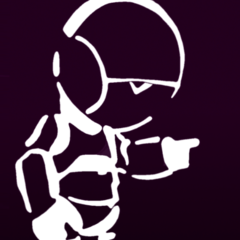-
Posts
62 -
Joined
-
Last visited
About Slartibartfast
- Birthday 01/01/1980
Personal Information
-
Flight Simulators
DCS World, Microsoft Flight Simulator
-
Location
Australia
-
Interests
FPV, drones & motorcycles.
Recent Profile Visitors
The recent visitors block is disabled and is not being shown to other users.
-

Honey, I developed FFB joystick (DIY)
Slartibartfast replied to propeler's topic in PC Hardware and Related Software
Huh, you're right! Somehow I did manage to download the HTML file. Bizarrely though right-clicking on the link I actually posted though does actually work: https://raw.githubusercontent.com/walmis/FFB-Joystick-Base/master/CAD/BOX-8mm-plywood-6374_motor.step I must have somehow downloaded one file and posted a link to another. -

Honey, I developed FFB joystick (DIY)
Slartibartfast replied to propeler's topic in PC Hardware and Related Software
That is a very interesting and ingenious design you have there @propeler and I too have spent some time analysing the mechanics. Unfortunately however, unlike @Bard_the_Bowman, I'm not convinced that the axis are truly separated. I grant that the forward/back axis as pictured does have a direct 1:1 coupling with the pully at all times, and the left/right axis will have an (almost) 1:1 coupling while the first axis is vertical; however when the first axis is inclined the second axis will no longer be 1:1 with its pully. The second axis action will become more and more separated from the pully the further the first axis is deflected until, in the extreme, if the first axis were to be deflected by a full 90° the second axis pully would have no effect at all. I grant that in the typical range of motion this effect may not be significant however it is still the case that the two axis are not truly independent. -

Honey, I developed FFB joystick (DIY)
Slartibartfast replied to propeler's topic in PC Hardware and Related Software
Yeah, I had the same problem with Walmis' file. No idea what the problem is. -

Honey, I developed FFB joystick (DIY)
Slartibartfast replied to propeler's topic in PC Hardware and Related Software
Nice! I take it that the lugs that hold that second "inner" axle are printed as separate pieces and attached after. It looks like that would lend itself well to mounting the logs on the other side of those arms to give the off-set gimble others have mentioned. Exactly how that would connect to the belt and mesh with the motor remains to be seen but from this point it looks like it could well be doable: How do you think those parts would go being used to create a mold from which to cast mettle pieces? Is it feasible to cast pieces with through holes in them like those? If not, perhaps one could cast a piece with "starter divots" that are then drilled out after. -

Honey, I developed FFB joystick (DIY)
Slartibartfast replied to propeler's topic in PC Hardware and Related Software
I take it you're referring to this file: https://raw.githubusercontent.com/walmis/FFB-Joystick-Base/master/CAD/BOX-8mm-plywood-6374_motor.step I've been trying to work with this but can't find a program to open it. I have tried several STEP viewers (including Fusion 360) and every one fails to open saying the file is either corrupt or invalid. Have you had any luck opening the file? I too have a 3D printer and wanted to have a go at printing it. -
Arr, okay. Thanks guys:
-
Well, after a reboot it did indeed start working... but then the next time I played I was back to only 3 DOF: I realised this time that my throttle quadrant had become unplugged and although once plugged back in worked fine some of the switches were a little funny. I then realised that the time before when I only had 3 DOF I had booted DCS with my throttle unplugged as well and plugged it in once booted, so I restarted again with the throttle definitely connected and what do you know, 6 DOF again. I'm not sure if it's related or not but I use an X-56 Rhino and for some reason it prevents my PC from going to sleep so I tend to unplug it while not in use. Not sure if that's the reason or if it's just a coincidence but it seems to be working now:
-
After loading the wounded how are we meant to navigate to the hospital? It says to tune the ADF to 490kHz, and there is a signal playing at a little under 500khz. When tuned to it it seems to be playing "AV" in Morse and I followed it for the longest time but it sent me an incredibly long way away and when I finally arrived it was just at some random antenna. After getting rather frustrated I looked up a couple of walkthrough videos on YouTube and after the injured are loaded the person making the video simply says "I know where we are" and fly off to the South-West. This happened on both videos I watched. In the video one of the pilots did tune there radio to where mine was on the dial and seemed to hear a "T" broadcast in Morse and basically confirmed that yup, it was pointing in the direction they expected but I can't seem to find this frequency myself. Eventually they get close and it says to land inside the perimeter fence, the same as when we dropped the submariners off, but how are we meant to know to head in that direction in the first place. Anyway, I basically followed the examples in the video and was able to complete the mission myself, but how is it meant to be done?
-
Thanks for the suggestion @BIGNEWY but I don't think it's an issue with the headset itself. It actually tracks both rotation and translations really well in the "MS House" in the Mixed Reality Portal" and as I say it tracks rotations well in DCS and use to track translations before the update. Something changed with the update and I'm trying to work out what.
-
I've recently got a HP Reverb G2 and have to say I'm absolutely loving flying the Huey with this thing! Anyway, while it's been working great, today when I started up DCS World it did an update and after it relaunched a few things were off. Firstly it re-mapped everything on my HOTAS throttle. While this was annoying it was easy enough to fix however, for some reason, while the rotation of my VR headset tracks fine it no longer tracks translations, meaning it doesn't follow when I move my head in space –as in when I lean in to the dash or push to the side to get a better view out the corner of the window, the direction I'm looking is tracked fine however the actual position of my head appears to stay the same. I noticed this happened when I first tried the headset and was disappointed to to think that DCS simply didn't support head translations however after a little tweaking of settings, on one flight I was surprised to discover that head translations were indeed being tracked but I have no idea what I did. Since the update, try as I might I just cant work out what I adjusted before. Does anyone know how I can fix this?
-
Slartibartfast changed their profile photo
-
Yeah, it's kind of hard to tell from just the photos, which is why I have the concerns I have. There is a keyboard and mouse swivel tray available that looks as well made as the rest of the kit, so I'm not worried about that. If it's good that I'd be happy to spend the money; I just don't want to drop 1200 AUD on it only to find out it's poorly proportioned for flight sims. I do actually own MFG Crosswind pedals and am concerned about them fitting as well.
-
Is anyone familiar with Trak Racer's TR8 simpit: It's made by an Australian crew and appears to be primarily designed around sim racing rather than flying but looks as though it would lend itself to flight simming well enough. While there are plenty of generally favorable reviews of the rig in regard to racing, other than the manufacturer's website I haven't been able to find any discussion of it being used as a flight sim rig, and even then their 'Flight simulator" page keeps touting it suitability for racing, even saying: " The left and right-side flight sim mounts are included, as are the racing wheel mount, gear shifter and pedal mounts; just in case you decide to get into driving simulation also!"... which definitely gives you the feeling that flight simulation was an afterthought. The things that concern me are: The seemingly fixed location of the throttle and sidestick mounts Apparent limited adjustment and location of the yoke mount Seeming lack of ability to mount a centrestick Size and shape of the seat (I'm a big lad and plastic/fiberglass bucket seats always give me pause for thought) Is anyone familiar with this setup or know of any others that would be suitable?
-

Multi-monitor set-up guide & help (unofficial)
Slartibartfast replied to MadTommy's topic in Multi-Display Bugs
Thanks @klem. Ideally I'd actually like to build a 90° simpit. As it is I've been inspired by this X-Plane setup: and have a thread in the "Cockpits" section accordingly: https://forums.eagle.ru/showthread.php?t=269878 but I thought here may well be the best place to ask about configuration settings. As it is I was about to order a VR headset however after much deliberation and finally settling on the HP Reverb, right on the day when I logged in to make my purchase my feed was filled with teasers of the upcoming HP/Valve/Microsoft collaboration which, for lack of an official name, is being dubbed the "Reverb #2". In particular it was Microsoft's collaboration (given the upcoming and highly anticipated MS Flight Simulator) that gave me pause. So just as I was hovering over the "purchase" button I decided to hold off on a ordering. And, after being inspired by "Home Sim Pilot"s video above, I am trying to investigate whether such a 90° setup would be feasible in DCS. -

Multi-monitor set-up guide & help (unofficial)
Slartibartfast replied to MadTommy's topic in Multi-Display Bugs
Hello. I'm toying with the idea of setting up a multi display setup myself and am trying to workout how I should configure things. I've read several times that the "3 screen" setup isn't appropriate for most people because it's designed around three similarly sized monitors placed at 90° or 60° to each other - which is actually exactly what I want! My question is... is it 90° or 60° (or anything else) and how exactly should you configure things to achieve this? I'm also wanting to understand exactly what the ViewDx and ViewDy values represent. I know it's to do with view rotation but if I'm to go ahead with purchasing the gear for a 3 monitor setup I want to know exactly what I'll be dealing with and this seems the best place to ask. Thanks. -
Thanks @Noluck. In particular I'm wanting to understand what the "ViewDx" and "ViewDy" values represent. While ViewDx seems to "pan" the image to the left and right and ViewDy seems to "pan" up and down and "1" seems to represent a "screen width/height" it's not clear as to whether this is a "rotation" pan or a "translation" pan. As it is I've been digging a lot but haven't been coming up with much gold.

